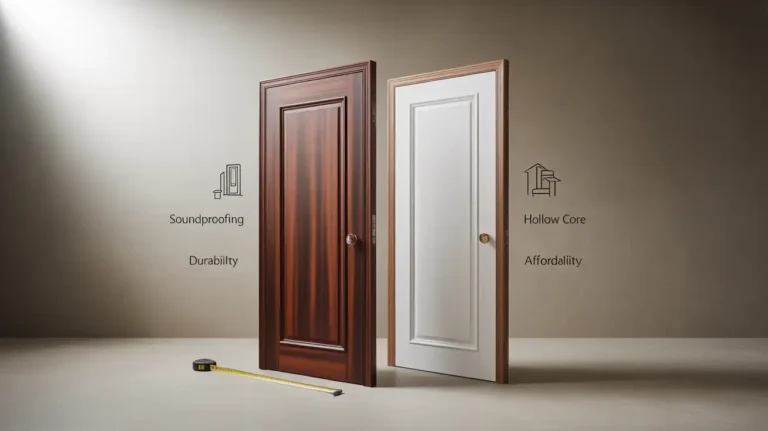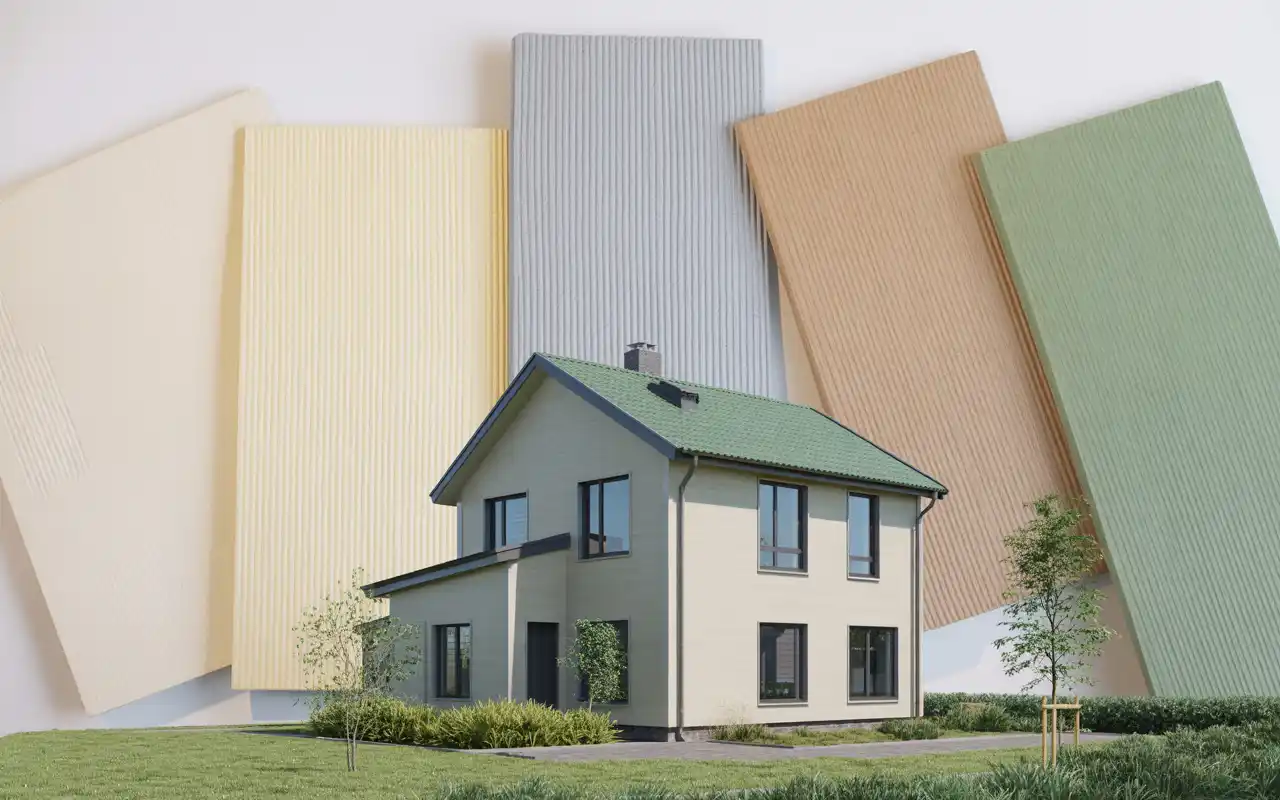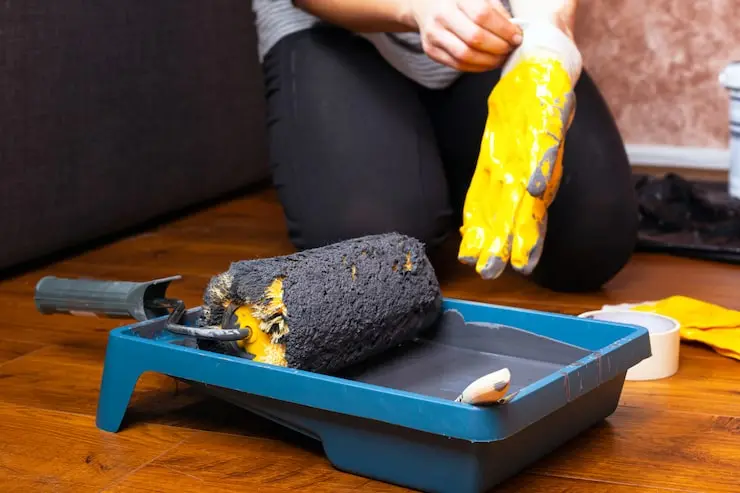Choosing the right interior doors isn’t just about looks, it’s about how they perform in your home every day. From sound control to strength and privacy, your door choice plays a big role in comfort and functionality. One of the most common decisions homeowners face is between solid core vs hollow core doors, and each has its own pros and cons.
Many homeowners in San Diego want doors that balance style, durability, and budget without sacrificing quality. This guide will help you understand the key differences between solid core vs hollow core doors so you can pick the one that fits your space and lifestyle best.
Table of Contents
Types of Interior Doors
When you’re updating your home, choosing the right type of interior door matters more than most people realize. Doors don’t just separate rooms; they help with privacy, reduce noise, and even improve energy efficiency. From solid core to hollow core options, and everything in between, understanding the materials can help you make the best decision for both style and function.
Here’s a quick look at the most common types of interior door materials and where they work best:
- Solid wood doors are often used in traditional or upscale homes. These wood doors for interior use offer a timeless look and excellent durability, but they come at a higher cost and may expand in humidity.
- Solid core doors are a popular choice for bedrooms and home offices. They provide a heavy, high-quality feel and block sound better than hollow alternatives.
- Hollow core doors are lightweight and more affordable, making them ideal for closets, pantries, or areas where insulation and noise reduction aren’t as important.
- MDF (medium-density fiberboard) is a budget-friendly option often used for painted doors. It resists warping and is smooth for a clean finish.
- Insulated interior doors, typically solid core or foam-filled, are perfect for rooms where temperature control or soundproofing is a concern.
Homeowners often prefer solid core interior doors for their balance of affordability and performance, especially in high-use areas. On the other hand, hollow core interior doors are great for secondary spaces where cost-saving is a priority. Understanding the role of each material helps ensure you choose a door that fits your space, budget, and long-term needs.
Solid Core Doors: Pros & Cons
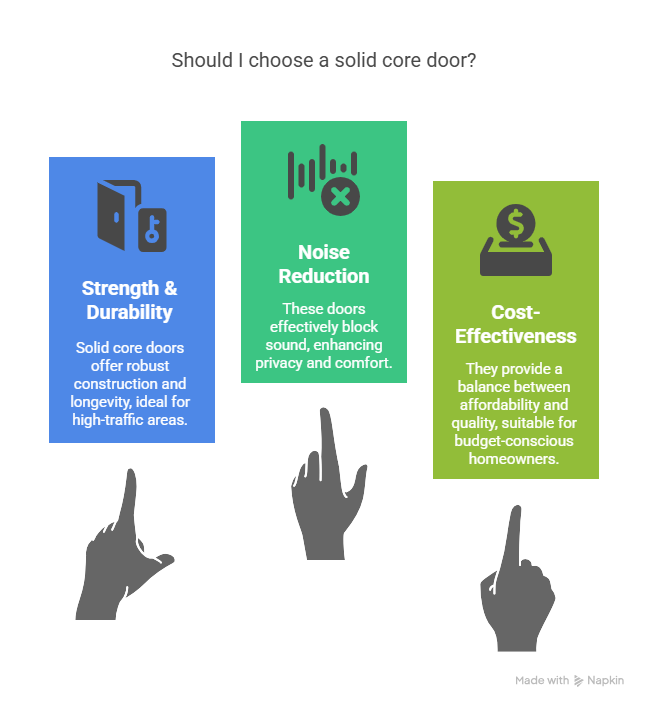
When homeowners look for a strong, long-lasting door that also helps reduce noise, the solid core door often stands out. Designed to mimic the feel and strength of solid wood interior doors, solid core options offer a practical middle ground between hollow core doors and more expensive solid wood entry doors. While they’re not made entirely of wood, they’re packed with durable material that gives them weight, strength, and sound-blocking benefits.
Solid Core Door Pros:
- Heavier and more durable than hollow core, making them ideal for bedrooms, offices, and living areas.
- Excellent sound insulation, often used when noise control is a priority.
- Offer the feel and strength of solid wood interior doors but at a more affordable cost.
- Many models have fire-resistant qualities, offering added safety.
- Perfect for high-traffic areas where doors are opened and closed frequently.
Solid Core Door Cons:
- Their weight makes them harder to install; most homeowners hire a professional.
- Solid core interior doors generally cost more than hollow core models.
- In humid climates, they can swell over time if not properly sealed, unlike some solid wood exterior door options that are treated for weather exposure.
If you’re wondering, “Are solid core doors better for soundproofing?” Yes, they’re a top choice for reducing noise between rooms, offering a quieter and more private indoor environment.
Hollow Core Doors: Pros & Cons
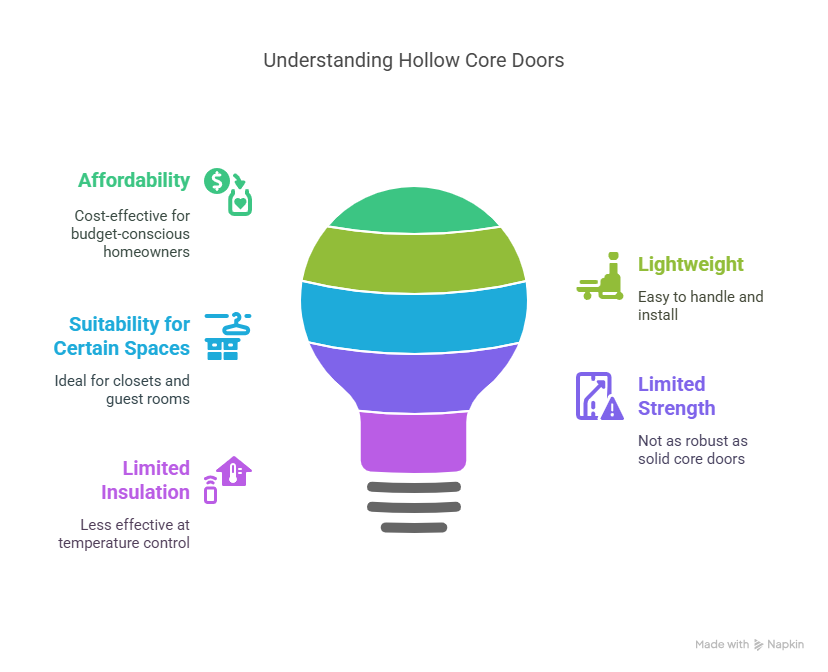
When it comes to affordable and lightweight options, the hollow core door remains a top pick for many homeowners. While it may not offer the same strength or insulation as solid options, it fits well in spaces like closets, guest rooms, or areas where privacy and sound control are not top concerns. In the ongoing debate of solid core vs hollow core doors, it’s important to understand what makes hollow core styles practical for certain uses.
Hollow Core Door Pros:
- Lightweight and easy to install, making it a great choice for quick remodels or DIY projects.
- A budget-friendly option for homeowners looking to save without compromising on style.
- Ideal for closets, pantries, and other low-traffic areas where sound insulation isn’t necessary.
- Available in a wide range of designs and finishes, matching various home styles.
- Many hollow core interior doors can be upgraded to look like pricier materials at a fraction of the cost.
Hollow Core Door Cons:
- Offers poor sound insulation, which may not work well for bedrooms or offices.
- Prone to dents and damage due to its thin outer layer and hollow center.
- Lacks the weight and feel of a solid or insulated interior door, which some homeowners prefer.
In comparing hollow vs solid core doors, hollow models serve their purpose well in the right locations. But if you’re aiming for durability and sound control, they may not be the best fit. Knowing where to use each type can make a big difference in both comfort and long-term value.
Cost Comparison of Solid Core vs. Hollow Core Doors
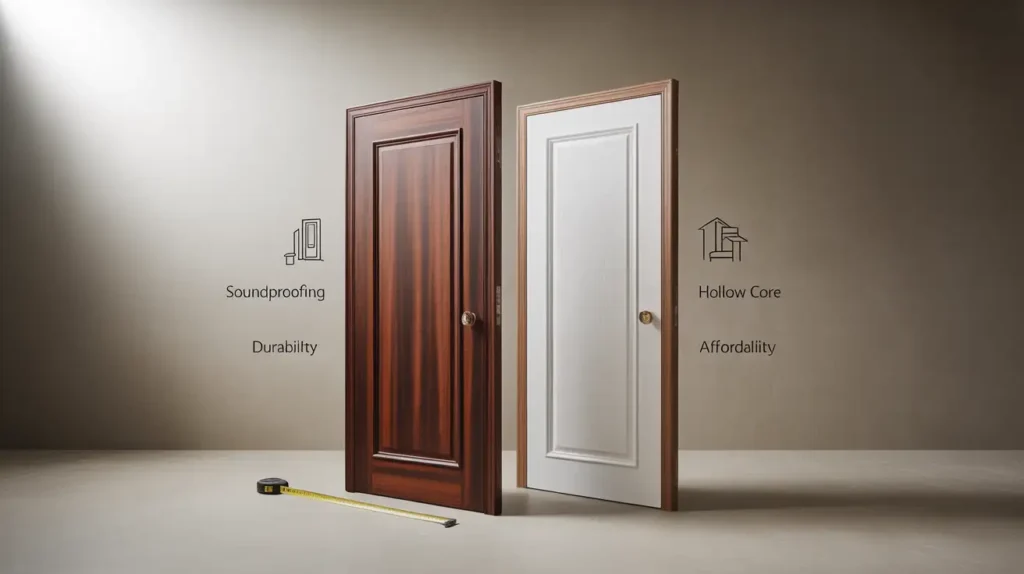
When planning a home remodel, cost is always a big factor especially when it comes to choosing the right interior doors. In the debate of solid core vs hollow core doors, the upfront price and long-term value can vary depending on your home’s layout and how you plan to use each room. Understanding the full cost picture helps homeowners make smart, lasting choices.
A solid core door generally costs more due to its dense structure and improved performance. Labor is also higher, since these doors are heavier and often require professional installation. On the other hand, a hollow core door is much lighter and easier to install, making it a great low-cost option, especially for rooms that don’t need soundproofing or added strength.
Here’s a quick breakdown comparing the two:
Feature | Solid Core Door | Hollow Core Door |
Material Cost (avg.) | $70 – $250 per door | $30 – $80 per door |
Installation Cost (avg.) | $100 – $200 per door | $50 – $100 per door |
Durability | High – Long-lasting | Moderate – Easily damaged |
Maintenance | Low – Resists wear | Moderate – Prone to cracks |
Sound Insulation | Excellent | Low |
Best Used In | Bedrooms, offices, main areas | Closets, laundry rooms |
Over time, solid core doors offer better value in spaces that need privacy, sound control, or daily use. However, if you’re remodeling on a tighter budget, a hollow core door can be the right fit for less-trafficked areas. The key is to match the door’s strength and insulation level with the room’s purpose of saving money without sacrificing function.
Deciding Between Solid Core vs. Hollow Core Doors
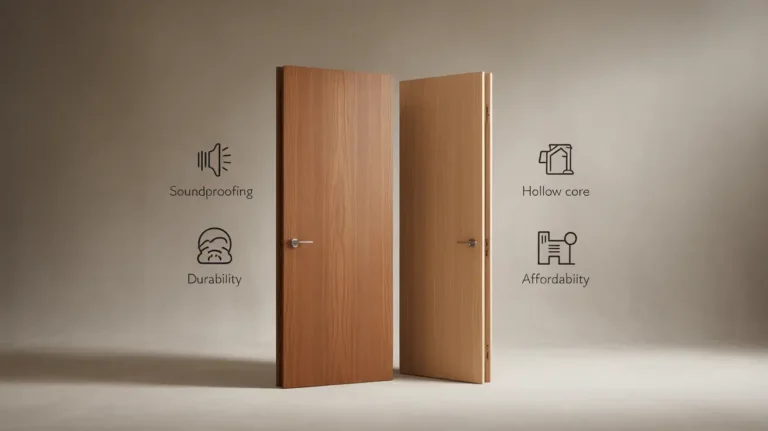
Choosing between a solid core door and a hollow core door depends on more than just price; it’s about matching the right door to the right space. In any room remodeling project, homeowners need to consider how the room will be used, the level of noise they want to block, and how much wear and tear the door will face. Asking the right questions upfront makes the decision clearer and more cost-effective in the long run.
Start by asking yourself:
- What’s your budget for this remodeling project?
- Is soundproofing important in this room?
- Will the door be used frequently or in a high-traffic area?
- Are you looking for a heavier, more solid feel or something light and easy to install?
- Do you want something long-lasting, or is affordability more important?
Here’s a quick guide:
- Use solid core interior doors in bedrooms, bathrooms, and home offices where sound control, privacy, and strength are important.
- Install hollow core interior doors in closets, laundry rooms, or pantries spaces that don’t need much insulation or durability.
- Choose solid core doors for their durability and better sound resistance in busy areas.
- Go with hollow core doors to stay on budget while keeping a clean, stylish look.
- Understand the differences in hollow vs solid core doors to prevent future replacements or regrets.
If you’re planning a full remodel and not sure which door goes where, our Room Remodeling Services can help you create a balanced design that fits both your lifestyle and your budget. We guide you through every detail, including the right interior door choices for every space.
Professional Door Installation and Repair
Installing a door may seem simple, but the truth is getting it right takes skill, especially with heavy, soundproof options like a solid core door. Proper alignment, secure hinges, and a tight seal are all crucial to how well your door performs. Poor installation can lead to issues like uneven gaps, sticking, or reduced sound insulation. That’s why trusting a trained professional is often the smartest move for long-term results.
At San Diego Home Remodeling, we offer expert door installation and repair services backed by years of hands-on experience. Whether you’re upgrading to solid core interior doors or replacing older hollow core doors, our team ensures every door is fitted with care and precision. We don’t just install, we make sure your doors function smoothly and look great in your home’s design.
By choosing our Handyman Services, you get:
- Local professionals who understand San Diego homes and building codes
- Reliable workmanship that prevents costly future repairs
- Custom solutions tailored to your remodeling goals
- Honest advice on materials and placement based on real-world experience
Ready to take the guesswork out of your door project? Contact San Diego Home Remodeling today to schedule a consultation and let our team handle your installation with the professionalism and care your home deserves.
FAQs
Which door is better for bedrooms: solid core or hollow core?
Solid core doors are better for bedrooms because they offer more privacy, better sound control, and a stronger, more secure feel. They’re ideal for spaces where peace and quiet matter.
Do solid core doors block noise better than hollow core?
Yes, solid core doors block noise significantly better than hollow core doors. Their dense inner material helps reduce sound transfer, making them great for bedrooms, offices, and shared walls.
Are solid core doors worth the extra cost?
For high-traffic areas or rooms where noise control and durability are important, solid core doors are well worth the extra cost. They last longer, resist damage, and feel more substantial than hollow options.
What is a solid-core door?
A solid-core door is built with a dense inner material, usually wood composite, that mimics the feel of a solid wood door. It offers better strength, insulation, and soundproofing than hollow-core options.
What is a hollow-core door?
A hollow-core door has a lightweight structure with a cardboard or plastic honeycomb interior. It’s cost-effective and easy to install, making it a popular choice for closets and low-traffic rooms.

